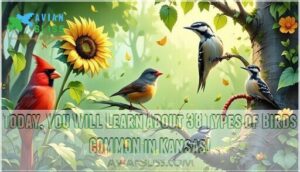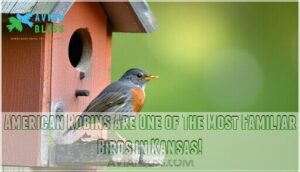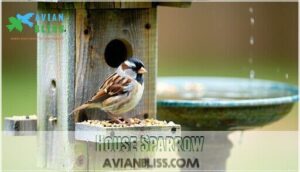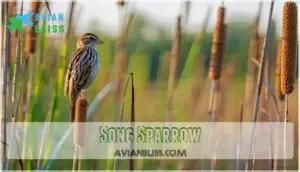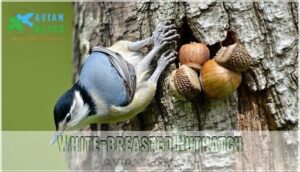This site is supported by our readers. We may earn a commission, at no cost to you, if you purchase through links.
 You’ll spot 38 different backyard birds of Kansas throughout the year, thanks to the state’s prime location along the Central Flyway migration route.
You’ll spot 38 different backyard birds of Kansas throughout the year, thanks to the state’s prime location along the Central Flyway migration route.
Northern Cardinals, Downy Woodpeckers, and American Robins frequent your feeders regularly, while seasonal visitors like Dark-eyed Juncos arrive in winter and Mourning Doves dominate summer months.
Kansas’s diverse habitats—from urban parks to prairie edges—create perfect conditions for both year-round residents and migrating species.
American Goldfinches work thistle feeders with their distinctive bouncing flight, while White-breasted Nuthatches announce themselves with sharp calls as they spiral down tree trunks.
The timing of when you’ll see specific species depends entirely on understanding their unique behavioral patterns.
Table Of Contents
Key Takeaways
- You’ll attract the most birds by offering sunflower seeds for cardinals and house finches, suet for woodpeckers, and thistle for goldfinches at your feeders
- Kansas sits on the Central Flyway migration route, so you’ll see both year-round residents like Northern Cardinals and seasonal visitors like Dark-eyed Juncos in winter
- You can identify common species by key features: American Robins have brick-red breasts, Downy Woodpeckers are small with black-and-white patterns, and White-breasted Nuthatches climb headfirst down trees
- Timing matters for bird watching—American Goldfinches breed late in summer when seeds ripen, while maintaining consistent feeding schedules and fresh water sources keeps birds visiting regularly
Today, You Will Learn About 38 Types of Birds COMMON in Kansas!
Kansas beckons with thirty-eight common backyard birds waiting to capture your attention.
Looking at the tone and content of the article, here’s an engaging blockquote that matches the enthusiastic, discovery-focused style:
Kansas transforms ordinary backyards into extraordinary birding adventures with these feathered neighbors.
From the brilliant scarlet flash of Northern Cardinals to the acrobatic antics of Black-capped Chickadees, these feathered neighbors transform ordinary mornings into wildlife adventures.
Understanding kansas bird species starts with recognizing their unique behaviors.
Watch American Robins hunt earthworms while Red-bellied Woodpeckers scale tree trunks searching for insects.
Kansas Habitat diversity—from prairie grasslands to wooded creek bottoms—supports this remarkable variety.
Bird Feeding attracts species like House Finches and American Goldfinches, while understanding Nesting Habits helps you spot breeding pairs.
Feather Care observations reveal fascinating grooming behaviors.
Bird Migration patterns bring seasonal visitors alongside year-round residents.
Your backyard birding journey begins with simple observation.
Common kansas birds offer endless discovery opportunities, making kansas backyard birds identification both rewarding and accessible for beginners and experts alike.
American Robin
American Robins rank among Kansas’s most recognizable birds, featuring distinctive gray-brown backs and brick-red breasts that make identification straightforward.
You’ll spot these thrushes year-round across the state, from suburban lawns to woodland edges where they hunt for earthworms and insects.
American Robins Are One of The Most Familiar Birds in Kansas!
You’ll spot American Robins year-round in Kansas backyards, making them perfect ambassadors for backyard birding enthusiasts.
These familiar thrushes showcase distinctive brick-red breasts against gray-brown upperparts, creating unmistakable feather colors that make bird watching Kansas adventures rewarding.
Their robust presence in robin habitat across Kansas wildlife areas demonstrates remarkable adaptability to urban environments and natural settings alike.
The construction of bird house kits can support their nesting habits and provide insight into their behavior.
American Robin Range Map
Across North America’s vast expanse, American Robin migration patterns showcase remarkable adaptability. These Kansas birds breed from Alaska to southern United States, with Kansas positioned centrally within their enormous range.
During Robin Migration, thousands gather in Kansas backyards, creating spectacular displays of Kansas Wildlife behavior.
Bird Habitat preferences shift seasonally as flocks move between breeding and wintering grounds. Kansas bird diversity benefits tremendously from these continental travelers.
Backyard bird watching enthusiasts can observe distinct Feather Patterns and behaviors throughout the year.
Bird range maps reveal Kansas birds serve as essential stopover points during migration. Nesting Sites vary dramatically across their range, demonstrating remarkable ecological flexibility in American Robin populations.
The selection of wintering areas is influenced by climatic variation patterns that play a vital role in the migration and establishment of these bird species.
Downy Woodpecker
You’ll spot Downy Woodpeckers at your feeders year-round, where they’re attracted to suet, sunflower seeds, and peanuts.
These small black-and-white birds measure just 5.5-6.7 inches and make distinctive high-pitched whinnying sounds that help you identify them before you even see them.
Downy Woodpecker Range Map
You’ll find Downy Woodpeckers throughout Kansas year-round, making them reliable companions in your backyard birding adventures.
These adaptable Kansas birds thrive in diverse Woodpecker Habitat, from urban parks to rural woodlots.
Unlike many species that follow Bird Migration patterns, Downies stick around through harsh winters, becoming essential components of Forest Ecology.
Kansas Wildlife benefits from their pest control services as they hunt bark beetles and wood-boring insects.
Bird range maps show their consistent presence across the state, contributing to Kansas bird diversity.
Their year-round residency makes Woodland Conservation efforts vital for maintaining stable populations.
- Drumming on metal gutters during dawn chorus
- Clinging upside-down while foraging on suet feeders
- Excavating nest holes in dead tree limbs
- Chasing competitors away from prime feeding spots
- Performing aerial courtship displays in early spring
What Sounds Do Downy Woodpeckers Make?
Someone drumming on your backyard tree might be a Downy Woodpecker creating its signature percussion patterns. These smallest North American woodpeckers produce distinctive drumming sounds that serve as territorial markers and mating calls.
You’ll recognize their soft, rhythmic drum rolls lasting 1-1.5 seconds, accompanied by high-pitched "peek" calls and nasal whinnying sounds.
Their drumming frequency increases during spring breeding season as they establish territories and attract mates. Unlike songbirds, Downy Woodpeckers rely primarily on these percussive sounds rather than complex vocalizations for communication.
Understanding woodpecker drumming behavior is essential to recognizing the purpose and patterns of these sounds in your backyard.
| Sound Type | Pattern | Purpose |
|---|---|---|
| Drumming | Short rolls (1-1.5 seconds) | Territory marking, mate attraction |
| Peek calls | High-pitched single notes | Contact communication |
| Whinnying | Nasal, descending calls | Long-distance signals |
Learning these bird vocalizations helps you identify Kansas backyard birds and appreciate nature’s acoustic diversity in your own outdoor space.
Hairy Woodpecker
You’ll often spot Hairy Woodpeckers in Kansas’s mature forests, where they prefer large trees over the backyard feeders that attract their smaller cousins.
These black-and-white striped birds look nearly identical to Downy Woodpeckers, but three key features help you tell them apart with confidence.
Hairy Woodpecker Range Map
Hairy Woodpeckers inhabit mature forests across Kansas, representing the state’s rich Woodland Conservation efforts and Species Distribution patterns.
These medium-sized birds prefer Woodpecker Habitat with large trees for nesting and foraging.
- Forest Ecology: Thrives in deciduous and mixed woodlands with mature canopy
- Bird Migration: Shows partial migratory behavior during harsh winters
- Kansas bird watching: Best spotted in state parks and wooded river corridors
- Bird habitat preferences analysis: Requires dead trees for cavity excavation
Bird range maps analysis shows Kansas sits near their western range limit.
Unlike smaller cousins, Hairy Woodpeckers need substantial tree diameter for nesting cavities.
Bird species diversity in Kansas benefits from their insect control services, making them valuable woodland residents you’ll recognize by their bold patterns and resonant calls.
Understanding woodpecker species is essential for effective conservation efforts in the region.
Here Are The THREE Best Ways to Tell These Species Apart
Distinguishing between Downy and Hairy Woodpeckers challenges even experienced birders, but three key features make Kansas bird identification straightforward.
These backyard bird conservation favorites share similar Feather Patterns but differ in important ways. Focus on Bird Sizes, beak shapes, and tail markings for accurate Kansas birds identification.
To attract these species, consider installing woodpecker feeders in your backyard.
| Feature | Downy Woodpecker | Hairy Woodpecker |
|---|---|---|
| Overall Size | Sparrow-sized (5.5-6.7 inches) | Robin-sized (7.1-10.2 inches) |
| Bill Shape | Short, stubby beak | Long, chisel-like bill |
| Tail Feathers | Black spots on white outer feathers | Pure white outer tail feathers |
Size
When you spot a Hairy Woodpecker, you’ll immediately notice its impressive bird length of 9.4 inches – markedly larger than most Kansas bird species.
This substantial body mass makes it stand out among backyard birds, with a commanding wing span that creates distinctive flight patterns.
The bird’s size advantage becomes obvious when you compare it to smaller woodpeckers sharing the same habitat, its robust build and considerable feather depth give it a stocky appearance that’s hard to miss.
This bird wingspan allows for powerful, undulating flight between trees, and its size alone often provides the first identification clue for this species in Kansas bird species diversity, making it a notable example of a larger woodpecker with a distinctive flight pattern.
Bill
Engineering excellence defines the Hairy Woodpecker’s bill design.
This powerful tool delivers precision strikes against hardwood bark, revealing hidden insect treasures beneath.
You’ll notice the bill color remains consistently dark, perfectly matching Kansas bird species’ practical needs.
- Beak shape: Chisel-like tip creates clean rectangular excavations in tree trunks
- Pecking order: Strong bill structure allows dominance at backyard bird habitats during bird feeding
- Bird beaks functionality: Specialized tongue extraction system reaches deep crevices for larvae
This remarkable adaptation makes bird watching in Kansas particularly rewarding when observing Kansas wildlife behavior.
Outer Tail Feathers
When you examine a Hairy Woodpecker’s outer tail feathers, you’ll notice their distinctive white coloration—a key identification marker.
These specialized feathers, called rectrices, serve multiple functions in Kansas bird species. The feather structure creates a sturdy tripod against tree bark while foraging.
Unlike Downy Woodpeckers, Hairies show completely white outer tail feathers without black barring. This feather color difference helps with bird identification during backyard bird watching in Kansas.
The longer tail length enhances their bird silhouette and supports their unique flight patterns as they navigate between trees in Kansas wildlife bird habitats.
American Goldfinch
You’ll recognize American Goldfinches as bright yellow birds that frequent your feeders, especially drawn to thistle and sunflower seeds.
These strict vegetarians wait until late summer to breed, timing their nesting with peak seed production from plants like dandelions and thistles.
American Goldfinch Range Map
These golden-winged seed-lovers showcase remarkable Goldfinch Migration patterns across Kansas, with populations fluctuating seasonally based on food availability and breeding cycles.
- Spring arrival – Males develop bright yellow Feather Patterns during March-April breeding season
- Summer nesting – Pairs establish territories in open Bird Habitat areas with abundant thistle
- Late breeding – American Goldfinch delays nesting until July when seeds ripen
- Winter movements – Flocks gather in weedy fields, following their strict Finch Diet requirements
- Year-round presence – Some Kansas bird species populations remain resident while others migrate south
You’ll find these acrobatic performers throughout Kansas Wildlife areas, from suburban feeders to prairie edges.
Their nomadic lifestyle means they’ll appear when natural seed sources peak.
Kansas bird conservation efforts focus on maintaining diverse habitats that support their specialized dietary needs.
These Kansas wildlife birds demonstrate how Bird Habitat quality directly impacts population distribution, making backyard feeding stations essential stopover points during their seasonal wanderings.
To Identify Them by Sound, Listen for a Pretty Series of Musical Trills and Warbles
American Goldfinches create distinctive bird songs featuring musical trills and warbles that last several seconds.
These sound patterns help with bird vocalization identification in your backyard. Males produce complex song structure with repeated phrases in random order, showcasing impressive vocal learning abilities.
Listen for their signature "po-ta-to-chip" contact call during flight. Bird calls serve different purposes – songs attract mates while contact calls maintain flock communication.
Their bird vocalizations analysis reveals unique trill recognition patterns that distinguish them from other finches through specific bird vocalization patterns. The goldfinch call products are useful for understanding these distinctive sounds and vocal learning abilities.
House Sparrow
These chunky invasive birds have colonized nearly every Kansas backyard since their introduction from Europe in the 1850s.
- Gray crown and black bib – Males sport distinctive facial markings that make identification straightforward
- Chubby brown and gray bodies – Their robust build helps them survive harsh Kansas winters
- Loud chirping and calls – Social flocks create constant chatter around feeders
House Sparrow behavior centers on community living. You’ll spot them hopping beneath bird feeders, snatching cracked corn and breadcrumbs. Their nesting habits involve aggressive competition for cavities, often displacing native species from birdhouses.
Feather patterns distinguish males from females – males display bold black bibs while females show muted brown streaking. Their sparrow diet includes seeds, insects, and human food scraps.
Habitat preferences lean toward urban areas where they’ve mastered backyard bird watching scenarios. These kansas backyard birds represent successful adaptation, though their presence impacts native kansas bird species. For kansas bird sightings, check telephone wires and building eaves where they commonly perch. Understanding their house sparrow habits is essential for managing their influence on local ecosystems.
House Finch
House finches bring vibrant colors and lively chatter to Kansas backyards year-round.
These sparrow-sized songbirds showcase remarkable adaptability since their eastward expansion from western North America in the 1940s.
Males display brilliant red plumage on their heads and chests, while females sport subtle brown streaking that provides excellent camouflage during nesting season.
Finch Behavior patterns reveal their social nature:
- Flocking habits – Groups of 10-50 birds descend on feeders simultaneously
- Vocal communication – Constant chatter helps maintain flock cohesion during feeding
- Territorial displays – Males sing from prominent perches to establish breeding territories
**Bird Feeding success depends on proper seed selection.
Black oil sunflower seeds attract house finches consistently, while nyjer thistle provides essential oils for their Finch Diet**.
Backyard Finches prefer tube feeders and platform feeders positioned near shrubs for quick escape routes.
Kansas bird species like house finches don’t migrate extensively, making them reliable Kansas wildlife birds for backyard bird watching enthusiasts.
Their Finch Migration patterns involve short-distance movements following food sources rather than seasonal relocations.
American Crow
You’ll recognize American Crows as the largest all-black birds in Kansas backyards, measuring up to 20 inches with glossy feathers and intelligent dark eyes.
These highly social birds display remarkable problem-solving abilities and can even learn to mimic human speech when raised in captivity, showcasing their intelligent nature.
American Crow Range Map
You’ll find these intelligent Kansas wildlife birds across most of the state, with populations concentrated in eastern and central regions.
American Crow habitat preferences include riparian corridors, urban areas, and agricultural lands where food sources are abundant.
American Crow Distribution in Kansas:
- Eastern Kansas – Dense populations year-round in wooded river valleys
- Central Plains – Common along waterways and farming communities
- Western Grasslands – Scattered sightings, mainly during bird migration periods
- Urban Centers – Thriving populations benefit from human-provided food sources
These adaptable Kansas bird species follow predictable crow behavior patterns, establishing territories near reliable resources. Their feather patterns remain consistent black throughout their range, making identification straightforward for birdwatchers studying bird species of kansas populations.
Believe It or Not, American Crows Are One of The Smartest Birds in Kansas
In the context of Crow Intelligence, you’ll discover these Smart Birds possess remarkable Avian Behavior that rivals primates.
American Crow populations throughout Kansas Wildlife demonstrate sophisticated problem-solving abilities, crafting tools and remembering human faces for years.
Don’t let the term "Bird Brain" fool you – these bird species of kansas showcase extraordinary cognitive skills that highlight kansas bird diversity and complex bird behavior among kansas wildlife birds.
Song Sparrow
Song Sparrows are the soundtrack of Kansas backyards, delivering their cheerful melodies from shrubs and thickets year-round. These streaky brown birds sport distinctive dark breast spots and gray crown stripes that make identification straightforward during backyard bird watching.
Their Song Habitat preferences include weedy fields, forest edges, and wetland margins where they forage for insects and seeds. Sparrow Behavior centers around territorial singing, with males belting out complex whistled phrases from exposed perches.
Listen for their signature "sweet-sweet-sweet" notes followed by buzzy trills. Kansas bird species like Song Sparrows don’t migrate far, making them reliable residents for bird watching in Kansas.
Their Nesting Habits involve building cup-shaped nests in dense shrubs, typically 1-4 feet above ground. Feather Patterns show heavy brown streaking above and bold spotting below.
These backyard bird watching tips help distinguish them from other Kansas sparrows: look for the prominent breast spot and listen for their musical complexity that supports bird conservation in Kansas. Understanding the sage sparrow habitat is also vital for broader bird conservation efforts in similar ecosystems.
White-breasted Nuthatch
You’ll spot the White-breasted Nuthatch acrobatically maneuvering down tree trunks headfirst—a sight that defies gravity.
These compact birds excel at tree climbing, using their strong toes to navigate bark surfaces while searching for insects and larvae.
Their distinctive nasal "yank-yank" calls echo throughout Kansas woodlands as they forage.
Whitebreasted Nuthatch behavior includes several fascinating patterns:
- Caching food by wedging seeds into bark crevices for later retrieval
- Circular foraging around tree trunks to locate hidden insects
- Cooperative feeding where pairs work together during breeding season
- Territorial calling to establish boundaries and communicate with mates.
For successful bird feeding, offer sunflower seeds, suet, and peanuts at your feeders.
These nesting patterns involve selecting tree cavities lined with soft materials.
Kansas bird species like nuthatches contribute to bird conservation in Kansas through their insect control services.
Backyard bird watching tips include observing their unique nuthatch habitat preferences for mature trees with thick bark.
Frequently Asked Questions (FAQs)
What is Kansass official state bird?
Kansas’s state bird is the Western Meadowlark, a stunning songbird that’s spotted year-round across the state. You’ll recognize this beauty by its bright yellow underparts and intricate brown-black patterned wings.
Which birds visit feeders most in Kansas?
You’ll spot Northern Cardinals, House Sparrows, and Black-capped Chickadees most often at your feeders.
These regulars love sunflower seeds, while Downy Woodpeckers prefer suet and American Goldfinches stick to nyjer seed exclusively.
When do American Goldfinches breed in Kansas?
Like clockwork, American Goldfinches breed late in Kansas, waiting until mid-summer when thistle seeds ripen.
You’ll notice their breeding activity peaks in July and August, perfectly timed with abundant seed production.
How many bird species live in Kansas?
You’ll find over 460 bird species throughout Kansas, with some sources noting up to 480 species. This impressive diversity includes year-round residents, seasonal migrants, and occasional visitors across the state’s varied habitats.
What attracts woodpeckers to Kansas backyards?
John discovered three Downy Woodpeckers visiting his Kansas feeder daily after adding suet cakes.
You’ll attract woodpeckers by offering suet, sunflower seeds, and peanuts at feeders, plus maintaining mature trees for nesting cavities and insect foraging opportunities.
Conclusion
These backyard birds of Kansas transform your outdoor space into a living theater of natural behavior.
By understanding feeding preferences, seasonal patterns, and habitat needs, you’ll attract year-round residents and seasonal migrants alike.
Cardinals prefer sunflower seeds at dawn, while goldfinches favor thistle feeders during afternoon hours.
Keep water sources fresh and maintain consistent feeding schedules, and your patience will be rewarded with daily visits from these remarkable species, creating lasting connections with Kansas’s diverse avian community.
- https://avianreport.com/identify-bird-visit-backyard-feeders-kansas/
- https://www.reliup.com/blogs/blog/top-5-most-common-backyard-birds-in-the-usa?srsltid=AfmBOopo5SJV5-lSbnC1nL_Pd9mGp6BVOsdSu4u1xKb1ICn48WqaDg6A
- https://www.aphis.usda.gov/sites/default/files/ks-2019-bdm-ea.pdf
- https://www.gutenberg.org/files/37210/37210-h/37210-h.htm
- https://explorer.natureserve.org/Taxon/ELEMENT_GLOBAL.2.106001/Spiza_americana

